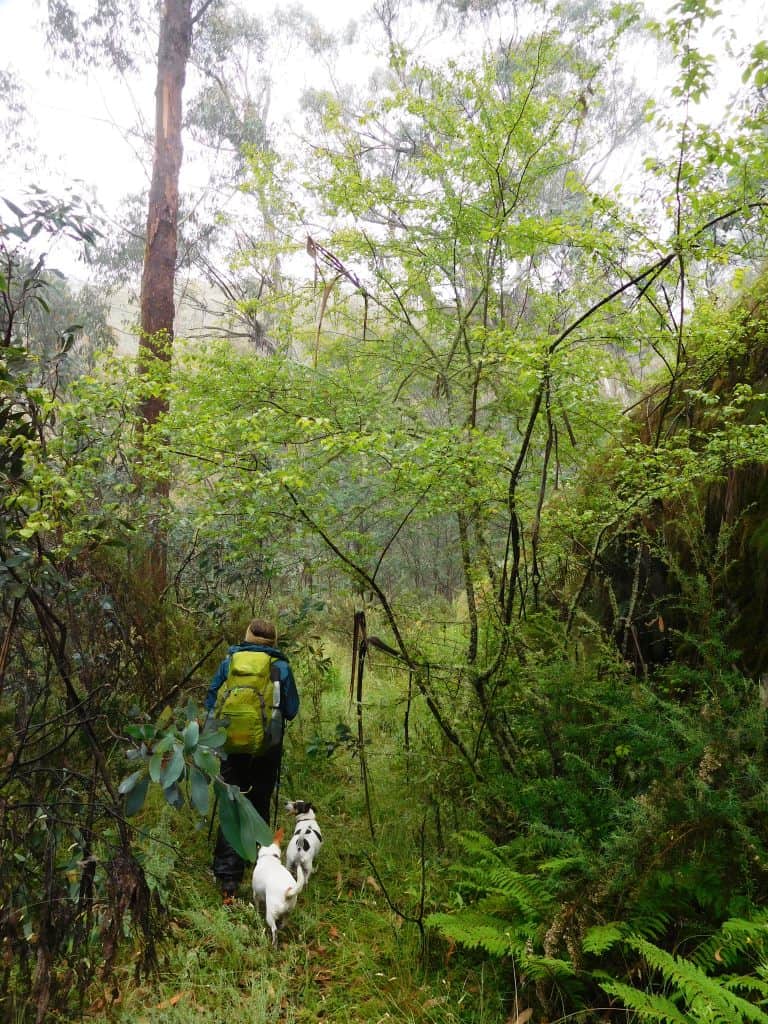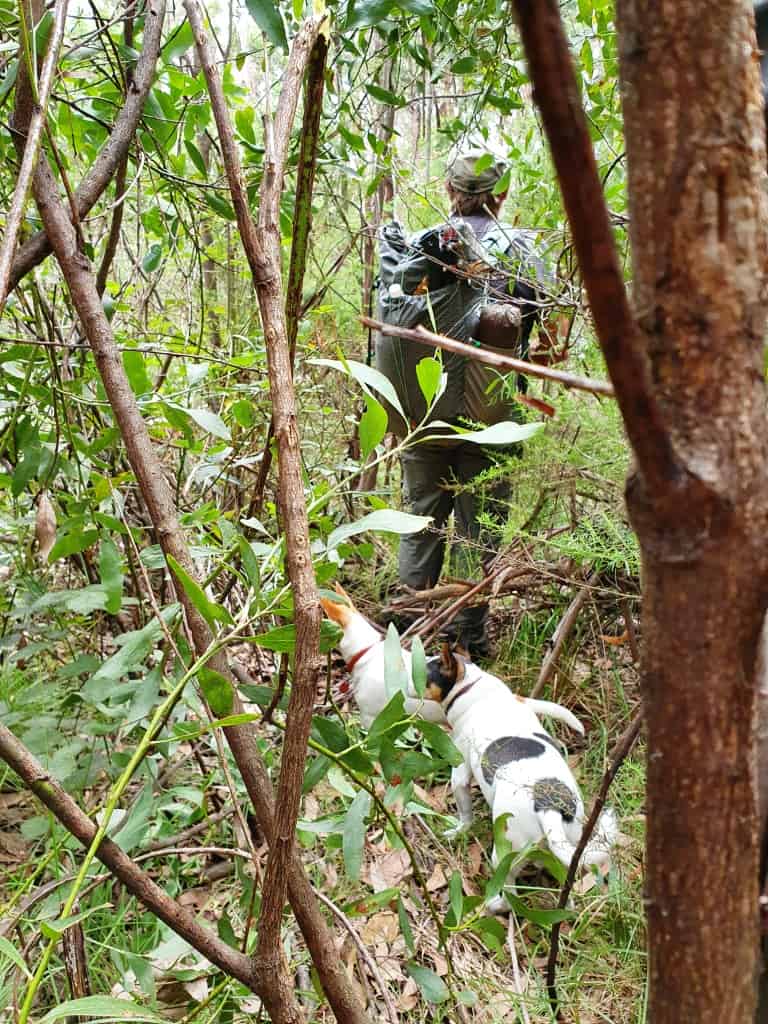First you figure out how to get your pack weight down to a sensible level say <5 kg skin out including your pack, mat sleeping bag, sat phone, sat messenger, shelter, first aid, cookset, clothes, pack rifle, ultralight fishing kit & etc – and hopefully you are able to do this without breaking the budget, ie for under $1,000 all up (sat phones etc are expensive but vital – how much is your life worth?) . You will find many suggestions, budget and DIY ideas on this page to help with those issues.
Then you must figure out how to ration your food and fuel (for less than 500 grams but over 2,000 calories per day) so that you can comfortably undertake say a ten day (unsupplied) hike beginning with a total pack weight of <10 kg (22 lbs). This is also not so hard. Some food ideas here.
I hope that you will have first learned a few things about bush survival and navigation before you go too far though, and that you continue to learn bushcraft skills which will enable you to live off the land and to provide yourself with water, food, warmth and shelter in any eventuality. These eventualities do arrive with alarming regularity. Thousands of people (needlessly) lose their lives every year in the backcountry for the lack of them! Don’t let it be you. As I earlier said, ‘How much is your life worth?’
As I have pointed out lots of times if you can just supplement your protein needs with some small game and/or fish you can easily reduce the weight of your food + fuel per day to less than 250 grams so that an averagely fit person starting out with a pack weight of say 20 kg should be able to comfortably continue unsupplied for two months+! Yes, really!
The first two things you must learn before you set out anywhere are how to light a fire (particularly in the wet) and how to find your way (without maps or electronic aids). I have pointed out again and again that the most important piece of equipment you need came into the world with you (unfortunately without an owner’s manual) – ie that which is located equidistant between your ears, but you need to learn how to use it – just like those other great tools your eyes, ears, nose hands feet back. When you get all of those things working well together you should never lack for anything, nor need assistance from Government of any other source!
I just hope you are listening. I have posted again and again explanations about how to do these things but once again: Here is some advice about fire lighting and here and here. Tinder is very important, as well as the means of starting one. Make sure you can always get a fire going even when it is raining and keep it going. Otherwise you may die! In such circumstances you need not worry overmuch about how big it is or where it is. If you have to light up huge (hollow) logs just do so. Warm is better than dead.
Never. Absolutely never venture into the bush without shelter and the ability to light a fire – even just to attend a call of nature! More people have ended up dying because they ‘just stepped off a track’ or road than practically any other cause. Certainly day walkers are much more likely to die than multi-day ones. Be warned. You only get one life. Spend it wisely.
It is also extremely vital eg to be able to ‘read’ The Lie of the Land, to find your way, stay on course and particularly to find water (eg read Hatchet) and purify it. I know most hikers cannot do any of these things. All they know how to do is shop! And often to be keyboard warriors! You need to become much more practical than that. Start now before it is too late! Forget about maps and electronic devices – learn how to do these things with your body and mind alone. First.
If you are well-prepared and reasonably knowledgeable about how ‘to travel the land’ then hiking can be a very pleasant and rewarding pass-time. I have spent a lot of time and effort writing these nearly 1500 posts. Take some time to read them before ‘rush in where angels fear to tread’.

Just a minute ago I was responding to a comment from a pack-rafter who though I had pointed out my posts about the Thompson River Gippsland’s many dangers and delights did not bother to read them before he/they set out at too high a water level, on too cold a day, with too many people, leaving too little time for the trip and with completely inadequate preparation eg as regards warmth, safety and waterproofness. Fortunately (by blind luck I should say) they survived, but they clearly had a miserable time and do not intend to return to a river which I have canoed with enormous pleasure (safely) a hundred times (even at well over seventy as I am now) – and by myself.
I have also several times pointed out such experiences I have had (with people who did not survive) as being quite safely and comfortably camped in my (appropriate) hammock in the wettest place on earth (Fiordland) just a couple of hundred yards away from another (much younger) person whilst he (unknown to me) was simply dying of poor preparation and ignorance (of hypothermia). I could easily have saved his life (as I have many others), had I known he was there – but he could have lived a long and interesting life if he had learned to read the advice which had been freely given before he undertook the trip. Several people every year die on the Dusky Track which I have hiked with great pleasure many times.
I say this in my ‘About’ section above, “I have camped out a lot, much more now than two years of my life in total. I have seen the failure of just about every type of gear, and experienced just about every disaster which can befall you in the wilderness, and survived. So, if you dream of doing a bit of camping, hiking or hunting, perhaps I can offer some useful advice?” ‘A word to the wise’ as they say…
Before you venture further afield can I suggest (insist) this, please: On a topographical map of some bush (forest) area, find one with some ‘fall’ in it ie containing valleys, one perhaps 2-3 km on each side and surrounded (please) by a road on all sides. Never mind whether you want to go there or not. Just do. You want an area which has no tracks or paths inside it. Do not take a map or compass. Just take the means to survive, but do this in relatively clement weather first (or you may not).

I want you to enter this area, walk at least half way in, take at least two 90 degree turns and find your way back to your point of origin without any artificial aid except your body and mind. Practice this exercise until you become very proficient at it. Be prepared to have to camp out for the night. You may well become ‘lost’ but you must hit a road so long as you walk in the same direction for 2-3 kilometres so you will find your way out (eventually) by rotating along the roads until you reach your point of origin. If you are afraid to undertake this exercise do not leave the sidewalk. Just stay in the confines of your urban life.
I expect this exercise will be very frightening to most (potential) and many (supposedly experienced) hikers. You could drop me in such an area which was 100 or even a thousand kilometres on a side and I would be fine, and find my way to wherever I wanted to go – probably end up even fatter at the end of it than when I began! I have spent most of my life just wandering around the trackless bush like this without a map. I know you have probably not, but you must start some time!
Please, before you do this read the posts I have indicated here carefully several times. You need to be sure you know how to find direction. You need to understand what I mean by the ‘lie of the land’. You need to be able to picture how the land falls away to the watershed and how one such is ‘divided’ from the next. You need to work out how to ‘find your way’ ie walk in a particular direction, to become attuned to the smallest animal paths – and so on. No-one else can do this for you. One day you will find yourself in this situation. It will be no problem at all if you are already prepared.
Once you have mastered that small piece of bush select an even larger one which s also delineated in some way (eg by roads, waterways cleared land etc) so that you can always find your way out eventually. Work your way up to the vastest wildernesses.
After you have mastered this skill practice camping out in such an area in every different weather and with more or less preparation, probably just starting with the simplest tarp. Gain experience before you venture too far afield. I have spent the night sitting on a thick piece of bark in a snowstorm wrapped only in one of those thin mylar space blankets. I do not recommend such a practice for every night but you should survive it as I have. Others failed to survive much smaller dangers.
Good luck, and happy camping.
See Also:
Ghost Shrimp and Other Small Fry
A Ball of String and a Feed of Cray
